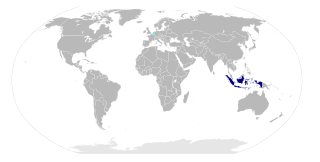Related Research Articles

Indonesian is the official and national language of Indonesia. It is a standardized variety of Malay, an Austronesian language that has been used as a lingua franca in the multilingual Indonesian archipelago for centuries. Indonesia is the fourth most populous nation in the world, with over 270 million inhabitants—of which the majority speak Indonesian, which makes it one of the most widely spoken languages in the world.

Malay is an Austronesian language that is an official language of Brunei, Indonesia, Malaysia, and Singapore, and that is also spoken in East Timor and parts of the Philippines and Thailand. Altogether, it is spoken by 290 million people across Maritime Southeast Asia.

Minangkabau is an Austronesian language spoken by the Minangkabau of West Sumatra, the western part of Riau, South Aceh Regency, the northern part of Bengkulu and Jambi, also in several cities throughout Indonesia by migrated Minangkabau. The language is also a lingua franca along the western coastal region of the province of North Sumatra, and is even used in parts of Aceh, where the language is called Aneuk Jamee.
Malaysian Malay, also known as Standard Malay, BahasaMalaysia, or simply Malay, is a standardized form of the Malay language used in Malaysia also using in Singapore and Brunei. Malaysian Malay is standardized from the Johore-Riau dialect of Malay. It is spoken by much of the Malaysian population, although most learn a vernacular form of Malay or another native language first. Malay is a compulsory subject in primary and secondary schools.
Indonesian and Standard Malay are two standardised varieties of the Malay language, used officially in Indonesia on one hand and in Brunei, Malaysia and Singapore on the other. Both varieties are generally mutually intelligible, yet there are noticeable differences in spelling, grammar, pronunciation and vocabulary, as well as the predominant source of loanwords. The differences can range from those mutually unintelligible with one another, to those having a closer familial resemblance. The regionalised and localised varieties of Malay can become a catalyst for intercultural conflict, especially in higher education.
Moronene is an Austronesian language spoken in Bombana Regency, Southeast Sulawesi, Indonesia. It belongs to the Bungku–Tolaki branch of the Celebic subgroup.
The Ibanic languages are a branch of the Malayic languages indigenous to western Borneo. They are spoken by the Ibans and related groups in East Malaysia and the Indonesian province of West Kalimantan. Other Dayak languages, called Land Dayak, which are not Ibanic, are found in the northwest corner of Kalimantan, between Ibanic and non-Ibanic Malayic languages such as Kendayan and the Malay dialects of Sarawak and Pontianak.
The Minahasan languages are a subgroup of the Austronesian languages spoken by the Minahasa people in northern Sulawesi, Indonesia. They belong to the Philippine subgroup.

The Bungku–Tolaki languages are a group of languages spoken primarily in South East Sulawesi province, Indonesia, and in neighboring parts of Central and South Sulawesi provinces.
Palembang, also known as Palembang Malay, or Musi, is a Malayic language primarily spoken in about two thirds of South Sumatra Province in Indonesia, especially along the Musi River. It consists of two separate but mutually intelligible dialect chains: Musi and Palembang. The urban Palembang dialect is a koiné that emerged in Palembang, the capital city of South Sumatra. It has become a lingua franca throughout major population centers in the province, and is often used polyglossically with Indonesian and other regional languages and dialects in the area. Since parts of South Sumatra used to be under direct Malay and Javanese rule for quite a long time, the speech varieties of Palembang and its surrounding area are significantly influenced by Malay and Javanese, down to their core vocabularies.
Kei is an Austronesian language spoken in a small region of the Moluccas, a province of Indonesia.
Tombulu, also known as Minahasan language, is an Austronesian language of northern Sulawesi in Indonesia. It is a Minahasan language, a sub-group of the Philippine languages.
Kendayan, or Salako (Selako), is a Malayic Dayak language of Borneo. The exact number of speakers remains unknown, but is estimated to be around 350,000.
Kulisusu is an Austronesian language of Southeast Sulawesi, Indonesia. It is part of a dialect chain with two minor languages, Koroni and Taloki.
Bungku is an Austronesian language of Southeast Sulawesi, Indonesia. It is quite close to Wawonii. It was a local lingua franca before independence.
Padoe is an Austronesian language of the Celebic branch. It was traditionally spoken in the rolling plains south of Lake Matano in South Sulawesi province. In the 1950s, a portion of the Padoe-speaking population fled to Central Sulawesi to escape the ravages of the Darul Islam / Tentara Islam Indonesia (DI/TII) revolt. In 1991, it was estimated there were 5,000 speakers of Padoe in all locations.
Suwawa is a Philippine language spoken in North Sulawesi (Celebes), Indonesia. It is also known as Bonda, Bone, Bunda, Bune, Suvava, and Toewawa. The language mostly spoken in Suwawa District, Regency of Bone Bolango.
Waru is an Austronesian language of Southeast Sulawesi, Indonesia.
Rahambuu is an Austronesian language of Southeast Sulawesi, Indonesia.

Bungku people are an ethnic group who mostly resides in North Bungku, South Bungku, Central Bungku, and Menui Islands districts di Morowali Regency, in Central Sulawesi province of Indonesia. This ethnic group is divided into several sub-groups, namely Lambatu, Epe, Ro'tua, Reta, and Wowoni. Bungku people have their own language, called Bungku language, which is one of their characteristic and serves as a means of communication between themselves. They generally embrace Islam or Christianity.
References
- ↑ Tolaki at Ethnologue (18th ed., 2015) (subscription required)
- 1 2 3 Zalili Sailan and La Ode Sidu Marafad and Gusarmin Sofyan and Sahlan, and Hamuni. 1995. Tata Bahasa Tolaki. Jakarta: Pusat Pembinaan dan Pengembangan Bahasa, Departemen Pendidikan dan Kebudayaan.
- ↑ Mead, David. 1998. Proto–Bungku-Tolaki: Reconstruction of its phonology and aspects of its morphosyntax . PhD dissertation. Houston: Rice University, p. 19. hdl : 1911/19290